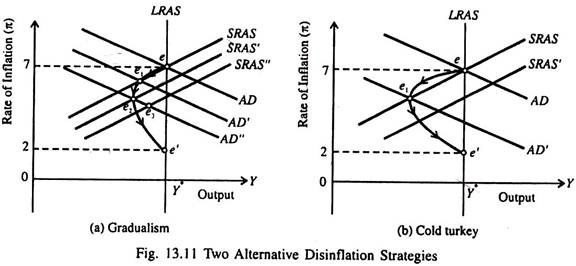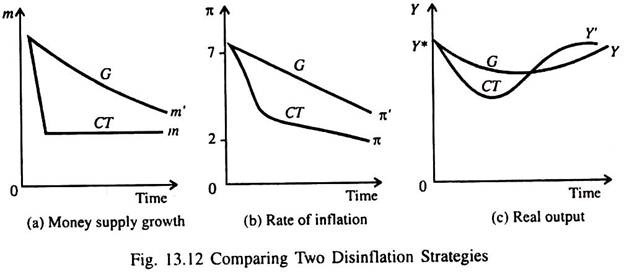The following points highlight the top two Alternative Strategies to Reduce Inflation. The Strategies are: 1. Gradualism 2. Cold Turkey.
Reducing Inflation Strategy # 1. Gradualism:
A policy of gradualism, shown in Fig. 13.11(a), attempts a slow and steady return to low inflation.
The gradualist policy starts with a small reduction in the money supply growth rate that shifts the aggregate demand curve down from AD to AD’, moving the economy along the short-run aggregate supply curve, SRAS, from e to e1.
In response to lower inflation rate at e1, the short-run supply curve shifts downward to SRAS’. A further decline in the money supply growth moves the economy to e2, the aggregate supply curve shifts down again to SRAS” and the process continues.
ADVERTISEMENTS:
Ultimately output returns to its full employment level at point e’, at a lower inflation rate. There is not much recession during the adjustment process, although actual unemployment exceeds its natural rate all through (implying positive cyclical unemployment).
Reducing Inflation Strategy # 2. Cold Turkey:
The alternative — cold turkey solution to inflation shown in Fig. 13.11(b) — seeks to cut the inflation rate very fast. For example, a rapid disinflation would lower output by 10% for 2 years. The strategy starts with an immediate sharp cut-back in money supply growth, shifting the aggregate demand curve from AD to AD’ and moving the economy from e to e1.
There is a deep recession, but because the aggregate supply curve is relatively flat, the reduction in inflation is small to begin with.
By creating a large fall in the inflation rate than when gradualism is used, the cold turkey strategy causes the short-run supply curve to move down faster than it does in Fig. 13.9(a).
ADVERTISEMENTS:
The cold turkey strategy keeps up the pressure by holding the rate of money supply growth low. Ultimately the rate of inflation drops down fast enough so that output and employment start rising. The economy returns to point e’ with full employment and lower rate of inflation.
Gradualism vs Cold Turkey:
We may now make a comparison of the above two scenarios. Fig. 13.12 presents the gradualist and cold turkey strategies in an alternative form. In the gradualist strategy the growth rate of money is initially reduced only slightly, and the economy never moves away from the natural rate of unemployment. But the inflation rate comes down very slowly.
ADVERTISEMENTS:
The cold turkey strategy, by contrast, starts with a huge cut in the growth rate of money supply and a deep recession. The recession is much worse than it ever is in the gradualist strategy, but the reduction in inflation rate is much rapid.
The choice of the correct strategy is a complex task. It depends on the costs of the two social evils — inflation and unemployment.
Theory and Evidence:
Historical evidence suggests that the reductions in inflation always come at the cost of temporarily lower output. Yet the size of the output loss varied from country to country and period to period. Rapid disinflations usually had smaller sacrifice ratios than slower ones.
That is, in contrast with what the Phillips curve with adaptive expectations suggests, a cold- turkey approach is less costly than the gradualist one.

